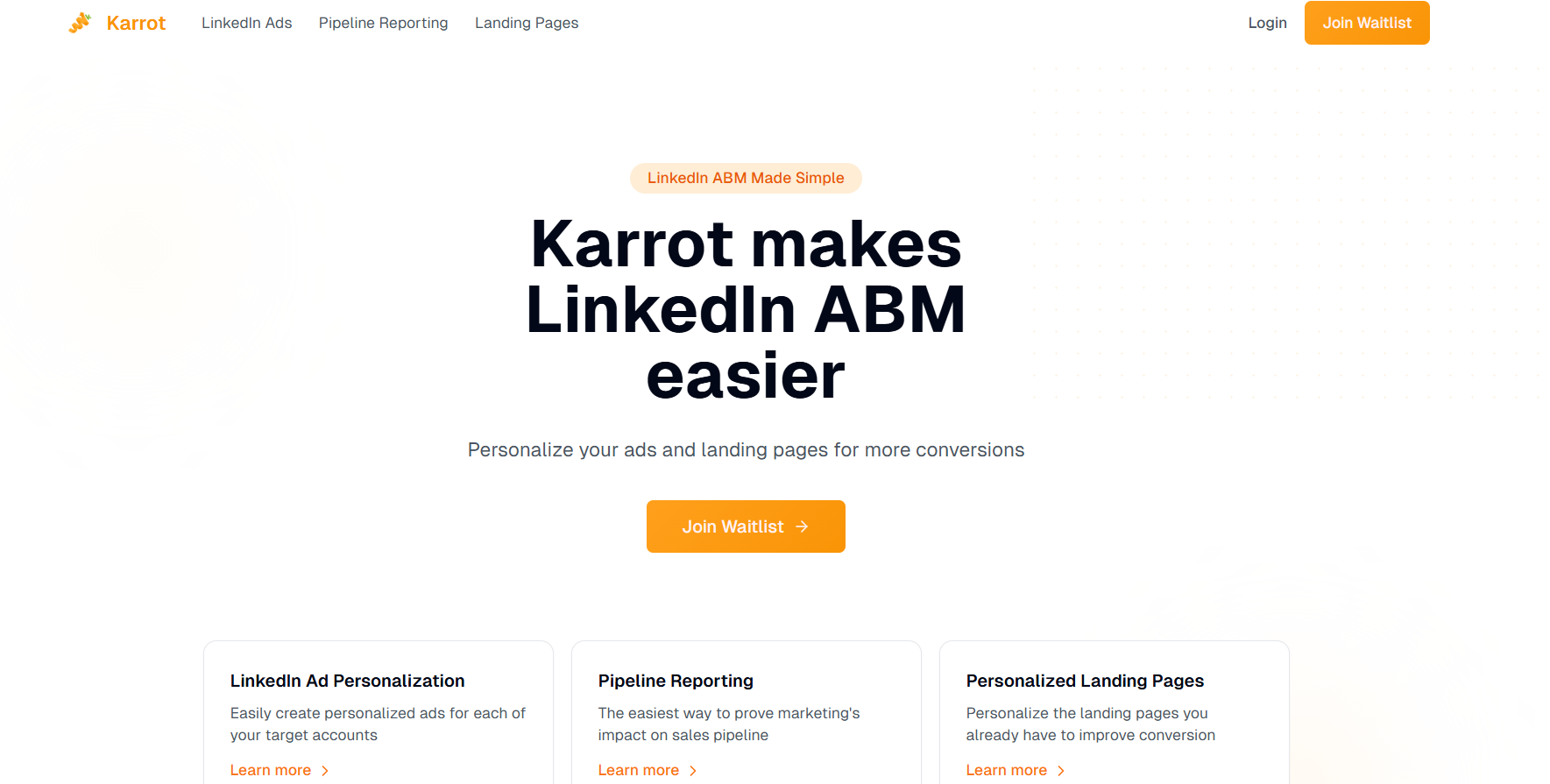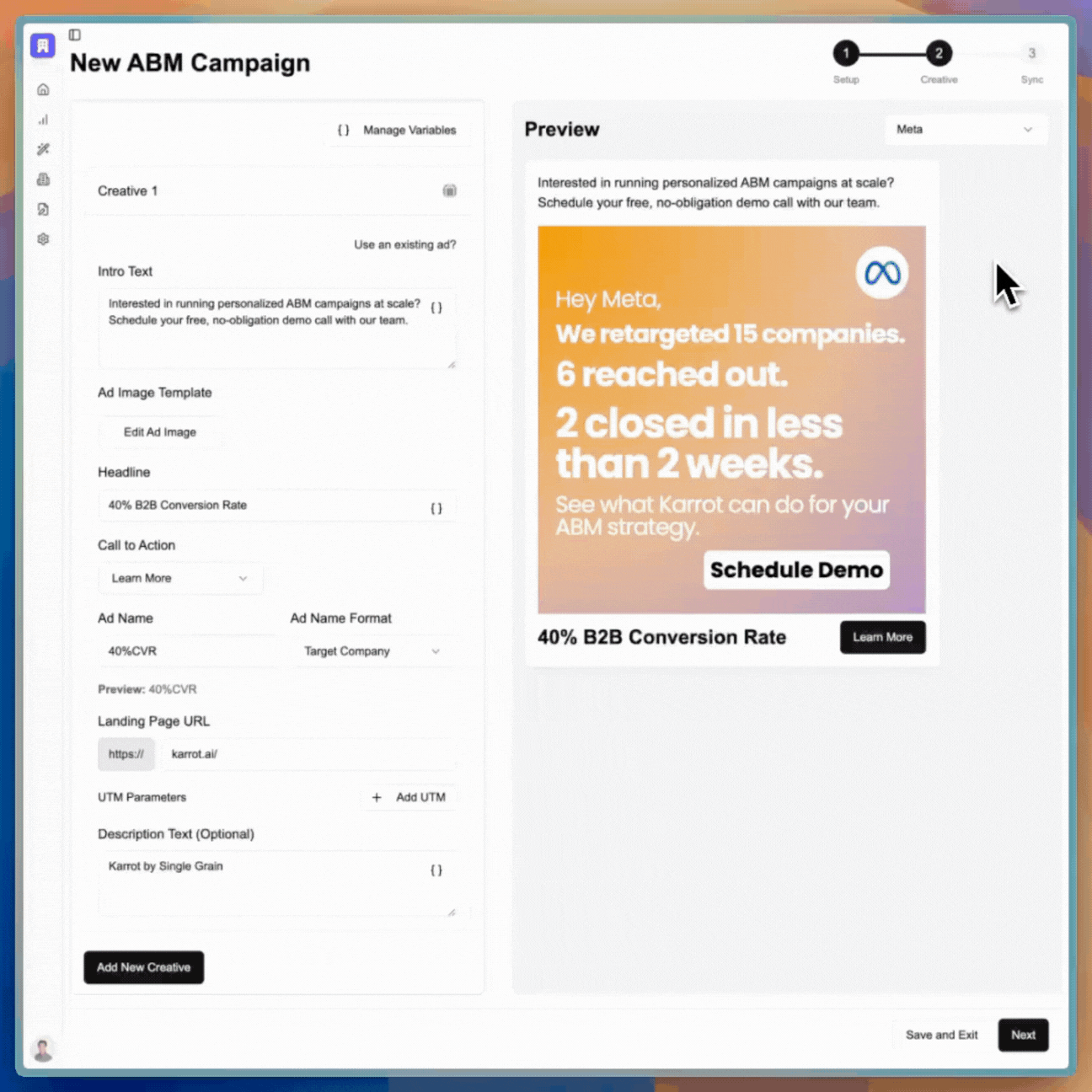How to Choose Best AI Tools for LinkedIn ABM: Platform Guide (2025)
LinkedIn account-based marketing has undergone a significant transformation in 2025, with AI-powered platforms now delivering unprecedented results for B2B enterprises. With generative AI cutting content creation time by up to 60% and B2B brands seeing an average 80% lift in conversion rates through hyper-personalized experiences, choosing the right AI tool has become critical for competitive advantage.
The challenge lies not in finding AI tools, but in selecting platforms that deliver measurable pipeline acceleration while maintaining the personal touch that drives B2B relationships. With 50% of B2B marketers now using ABM strategies and 61% reporting improved sales-marketing alignment, the stakes for choosing the right platform have never been higher.
Ready to transform your LinkedIn ABM strategy? Get Your Free ABM Audit to explore your options and discover how AI can accelerate your deal velocity.
TABLE OF CONTENTS:
- Our Evaluation Methodology: How We Assessed LinkedIn ABM AI Platforms
- Top 12 AI Tools for LinkedIn ABM: 2025 Rankings
- #1: Karrot.ai - Best Overall Choice ⭐
- #2: Demandbase - Best for Enterprise ABM
- #3: Terminus - Best for Multi-Channel Orchestration
- #4: RollWorks - Best for Mid-Market Value
- #5: 6sense - Best for Predictive Analytics
- #6: Metadata.io - Best for Automation Focus
- #7: SuperAGI - Best for Agentic ABM
- #8: Outreach - Best for Sales Integration
- #9: Drift - Best for Conversational ABM
- #10: Pardot (Marketing Cloud) - Best for Existing Salesforce Users
- #11: HubSpot - Best for All-in-One Solution
- #12: LinkedIn Campaign Manager - Best for Budget-Conscious Startups
- Comprehensive Platform Comparison: Feature Analysis
- Real-World Success Stories: AI ABM Performance Benchmarks
- Strategic Decision Framework: Selecting Your Optimal Platform
- Implementation Best Practices: Maximizing Your AI ABM ROI
- The Future of AI-Powered LinkedIn ABM: What's Next in 2025
- Making Your Optimal Platform Decision for 2025 Success
- Related Video
Our Evaluation Methodology: How We Assessed LinkedIn ABM AI Platforms
Our comprehensive analysis evaluated 50+ AI-powered LinkedIn ABM platforms using a rigorous methodology designed to identify solutions that deliver measurable business outcomes for B2B enterprises. Each platform was assessed across five critical dimensions that directly impact deal velocity and conversion optimization. We prioritized platforms demonstrating proven ROI through case studies, client testimonials, and documented performance improvements.
“The most successful LinkedIn ABM programs in 2025 combine AI-powered personalization with human strategic oversight, creating campaigns that feel personal at scale while maintaining brand authenticity.” – Industry Analysis
Primary Evaluation Criteria:
- AI Personalization Capabilities: Ability to create account-specific content, messaging, and creative assets at scale
- LinkedIn Integration Depth: Native platform connectivity, API utilization, and feature completeness
- Pipeline Attribution: Multi-touch tracking, deal velocity measurement, and closed-loop reporting
- Implementation Simplicity: No-code setup, user experience, and time-to-value
- Proven Results: Documented case studies, client retention, and performance benchmarks
Our analysis revealed that enterprise LinkedIn ABM programs leveraging advanced AI platforms recorded a 37% increase in engagement rates and a 42% reduction in lead costs, highlighting the transformative potential of selecting the right platform.
Top 12 AI Tools for LinkedIn ABM: 2025 Rankings
#1: Karrot.ai – Best Overall Choice ⭐

Karrot.ai emerges as the clear leader in LinkedIn ABM AI tools for 2025, combining sophisticated automation with intuitive usability that B2B enterprises demand. The platform’s strength lies in its ability to maintain brand consistency while delivering hyper-personalized experiences at scale, addressing the core challenge most organizations face when scaling ABM initiatives.
The platform’s LinkedIn Ad Personalization engine automatically creates account-specific ads using custom variables that extend far beyond basic company name insertion. Their template-based system includes a Canva-like editor that ensures brand compliance while enabling rapid creative deployment across thousands of target accounts. This addresses the critical bottleneck that prevents most companies from executing true one-to-one marketing at enterprise scale.
Key Differentiators:
- AI-powered content generation with brand-consistent creative output
- No-code implementation requiring zero technical resources
- Direct pipeline attribution through HubSpot integration with multi-touch modeling
- Personalized landing pages that maintain consistent user journeys from ads to conversion
- Template-based personalization ensuring quality control at scale
Karrot.ai’s Pipeline Reporting & Attribution capability provides timeline views of campaign effects, moving beyond unreliable last-touch attribution models to deliver true multi-touch insights. This enables B2B teams to demonstrate clear ROI and optimize campaigns based on actual pipeline influence rather than surface-level engagement metrics.
Best For: B2B enterprises seeking to scale personalized LinkedIn campaigns without sacrificing quality or requiring extensive technical resources.
Pricing: Custom pricing based on account volume and feature requirements, typically starting at enterprise-level investments that reflect the platform’s comprehensive capabilities.
Discover how Karrot.ai can accelerate your growth. Get Your Free ABM Audit to discuss your specific needs and see platform demonstrations.
#2: Demandbase – Best for Enterprise ABM
Demandbase positions itself as the enterprise standard for account intelligence and predictive ABM, offering deep CRM integrations and sophisticated intent data capabilities. The platform excels in large-scale implementations where complex buying committees and extended sales cycles require comprehensive account insights.
Best For: Large enterprises with complex sales processes requiring comprehensive account intelligence and intent data.
Strengths: Extensive integrations, proven enterprise track record, comprehensive reporting suite.
#3: Terminus – Best for Multi-Channel Orchestration
Terminus offers robust channel orchestration capabilities, enabling the coordination of campaigns across LinkedIn, email, and other digital touchpoints. The platform’s strength lies in creating consistent messaging across multiple channels while maintaining LinkedIn as the primary engagement vehicle.
Best For: Organizations requiring coordinated multi-channel ABM campaigns with LinkedIn as the primary channel.
Strengths: Channel coordination, marketing stack integration, campaign consistency.
#4: RollWorks – Best for Mid-Market Value
RollWorks offers cost-effective ABM solutions with robust Salesforce integration, making it an attractive option for mid-market companies seeking proven ABM capabilities without the complexity or investment typically associated with enterprise-level solutions.
Best For: Mid-market companies prioritizing cost efficiency with native Salesforce integration.
Strengths: Competitive pricing, Salesforce native features, and an established user base.
#5: 6sense – Best for Predictive Analytics
6sense leads in predictive ABM capabilities, using AI to identify in-market accounts and optimal engagement timing. The platform’s predictive models help prioritize accounts based on buying signals and intent data.
Best For: Organizations prioritizing predictive analytics and intent-based account identification.
Strengths: Advanced predictive capabilities, intent data integration, AI-powered insights.
#6: Metadata.io – Best for Automation Focus
Metadata.io emphasizes campaign automation and data-driven optimization, offering extensive customization options for organizations with specific workflow requirements.
Best For: Companies requiring highly customizable automation workflows and data-driven optimization.
Strengths: Automation depth, customization options, optimization algorithms.
#7: SuperAGI – Best for Agentic ABM
SuperAGI introduces autonomous AI agents for ABM execution, representing the cutting edge of AI-driven account engagement through intelligent automation that learns and optimizes continuously.
Best For: Organizations exploring autonomous AI agents for ABM execution and continuous optimization.
Strengths: AI agent technology, autonomous optimization, multi-channel capabilities.
#8: Outreach – Best for Sales Integration
Outreach offers robust sales engagement integration with LinkedIn ABM capabilities, prioritizing seamless handoffs between marketing and sales teams.
Best For: Organizations prioritizing sales and marketing alignment with integrated engagement workflows.
Strengths: Sales engagement integration, team coordination, workflow automation.
#9: Drift – Best for Conversational ABM
Drift combines conversational marketing with ABM targeting, enabling real-time engagement with target accounts through chat and messaging integration.
Best For: Companies seeking conversational engagement integrated with ABM targeting strategies.
Strengths: Conversational marketing, real-time engagement, messaging integration.
#10: Pardot (Marketing Cloud) – Best for Existing Salesforce Users
Pardot offers native Salesforce integration with LinkedIn ABM capabilities, providing seamless workflow integration for existing Salesforce customers.
Best For: Existing Salesforce customers seeking integrated ABM capabilities within their current ecosystem.
Strengths: Native Salesforce integration, existing user familiarity, comprehensive CRM sync.
#11: HubSpot – Best for All-in-One Solution
HubSpot offers comprehensive inbound marketing with LinkedIn ABM integration, providing an all-in-one platform for companies seeking integrated marketing automation solutions.
Best For: Companies seeking comprehensive inbound marketing with integrated ABM capabilities.
Strengths: All-in-one platform, user-friendly interface, comprehensive feature set.
#12: LinkedIn Campaign Manager – Best for Budget-Conscious Startups
LinkedIn’s native advertising platform offers basic ABM capabilities at lower cost points, making it suitable for organizations starting their ABM journey with limited budgets.
Best For: Startups and small businesses beginning ABM implementation with budget constraints.
Strengths: Native LinkedIn integration, lower cost entry, and direct platform access.
Comprehensive Platform Comparison: Feature Analysis
| Platform | AI Personalization | LinkedIn Integration | Pipeline Attribution | Implementation | Best For |
|---|---|---|---|---|---|
| Karrot.ai | Advanced AI content generation | Native automation | Multi-touch HubSpot sync | No-code setup | Enterprise scale personalization |
| Demandbase | Account intelligence | Deep API integration | Comprehensive reporting | Complex setup | Large enterprise |
| Terminus | Multi-channel coordination | Campaign orchestration | Cross-channel tracking | Moderate complexity | Multi-channel ABM |
| RollWorks | Standard automation | Basic integration | Salesforce native | Streamlined setup | Mid-market efficiency |
| 6sense | Predictive modeling | Intent data integration | Advanced analytics | Technical setup | Predictive ABM |
| Metadata.io | Customizable automation | API-based connection | Data-driven optimization | Custom configuration | Automation focus |
This comparison reveals that while multiple platforms offer LinkedIn ABM capabilities, Karrot.ai uniquely combines advanced AI personalization with no-code implementation, addressing the two primary barriers enterprises face: maintaining quality at scale and reducing technical complexity.
Real-World Success Stories: AI ABM Performance Benchmarks

The most compelling evidence for AI-powered LinkedIn ABM comes from documented case studies showing measurable business impact. For example, an enterprise software company utilized Karrot.ai to generate 1,000 LinkedIn leads. This resulted in a $12.4 million increase in influenced pipeline after only six months.
This case study illustrates a consistent pattern: organizations that achieve breakthrough results combine AI-powered personalization with strategic campaign orchestration, moving beyond basic automation to intelligent optimization that learns and continually improves.
Strategic Decision Framework: Selecting Your Optimal Platform
Choosing the right AI tool for LinkedIn ABM requires aligning platform capabilities with your organization’s specific objectives, technical requirements, and growth stage. Our decision framework guides you through the critical evaluation process.
Phase 1: Define Your ABM Objectives
Start by clarifying your primary goals: pipeline acceleration, cost reduction, or scale expansion. Organizations focused on maximizing reach through LinkedIn account-based marketing require different capabilities than those prioritizing conversion optimization.
Phase 2: Assess Technical Integration Requirements
Evaluate your existing marketing stack and CRM systems. Platforms like Karrot.ai excel with HubSpot integration, while others specialize in Salesforce environments. The depth of integration directly impacts data quality and attribution accuracy.
Phase 3: Determine Personalization Scale Needs
Consider whether you need account-level personalization, persona-based customization, or individual contact targeting. Advanced workflow automation and integration strategies become critical when scaling personalization across hundreds or thousands of accounts.
Phase 4: Evaluate Implementation Complexity
Assess your team’s technical capabilities and available resources. No-code solutions, such as Karrot.ai, enable rapid deployment, whereas enterprise platforms often require dedicated technical implementation teams.
Phase 5: Validate ROI Requirements
Determine your attribution needs and reporting requirements. Advanced platforms providing multi-touch attribution and pipeline influence tracking justify higher investments through improved optimization capabilities.
Need help choosing the right partner? Get Your Free ABM Audit to get personalized recommendations based on your specific requirements and growth objectives.
Implementation Best Practices: Maximizing Your AI ABM ROI
Successfully implementing AI-powered LinkedIn ABM requires strategic planning and systematic execution. The most successful programs follow proven strategies that maximize both short-term results and long-term scalability.
Start with account selection and segmentation
Begin by defining your Ideal Customer Profile (ICP) and segmenting target accounts based on buying stage, company characteristics, and engagement history. AI platforms perform best when fed high-quality account data and clear targeting parameters.
Develop brand-consistent creative templates
Create template frameworks that maintain brand consistency while enabling personalization at scale. This approach ensures quality control while allowing AI systems to generate account-specific variations efficiently.
Implement progressive personalization
Begin with basic company-level personalization, then progress to role-based and individual-level customization. This progressive approach enables teams to master platform capabilities while building confidence in the quality of AI-generated content.
Establish multi-touch attribution
Configure comprehensive tracking to measure campaign influence across the entire buyer journey. Successful LinkedIn ABM campaign implementation requires attribution models that capture both direct conversions and pipeline influence.
Optimize through continuous testing
Leverage AI capabilities for systematic A/B testing of messaging, creative elements, and audience segments. The most successful programs treat AI ABM as a continuous optimization process rather than a set-and-forget automation.
These implementation practices align with emerging trends in AI-powered ABM that emphasize intelligent automation combined with strategic human oversight.
The Future of AI-Powered LinkedIn ABM: What’s Next in 2025
LinkedIn ABM continues evolving rapidly, with several key trends shaping platform development and market dynamics. Understanding these trends helps inform long-term platform selection decisions and strategic planning.
Agentic ABM and Autonomous Optimization
Advanced AI agents are now capable of handling entire campaign lifecycles autonomously, from account identification to conversion optimization. These systems continually learn from engagement patterns and market responses, adjusting strategies in real-time without requiring human intervention.
Predictive Intent Integration
AI platforms are increasingly incorporating predictive intent data, identifying accounts that are entering buying cycles before they exhibit explicit interest signals. This capability enables proactive engagement when prospects are most receptive to messaging.
Cross-Platform Intelligence
Modern AI systems aggregate data across LinkedIn, website behavior, email engagement, and sales interactions to create comprehensive account intelligence. This holistic view enables more sophisticated personalization and timing optimization.
Dynamic Creative Optimization
AI platforms are moving beyond template-based personalization to generate entirely original creative assets based on account characteristics, industry trends, and performance data. This evolution represents a significant advancement in campaign relevance and engagement.
Organizations investing in AI-powered LinkedIn ABM platforms today position themselves to leverage these emerging capabilities as they become available, making platform selection a strategic decision with long-term implications.
The evolution toward AI-driven ABM innovations suggests that platforms combining current automation capabilities with future AI advancement potential offer the strongest value proposition for enterprise buyers.
Making Your Optimal Platform Decision for 2025 Success
LinkedIn ABM AI tools in 2025 offer unprecedented opportunities for B2B enterprises to accelerate pipeline velocity while maintaining personal relationships at scale. The key to success lies in selecting platforms that strike a balance between sophisticated AI capabilities and practical implementation requirements.
Karrot.ai emerges as the optimal choice for organizations prioritizing personalization quality, implementation simplicity, and measurable pipeline attribution. The platform’s unique combination of AI-powered content generation with no-code deployment addresses the two primary barriers preventing most companies from scaling ABM successfully: maintaining quality and reducing technical complexity.
The most successful LinkedIn ABM programs in 2025 will leverage AI not as a replacement for human strategy, but as an amplifier of strategic thinking that enables proper one-to-one marketing at enterprise scale. Organizations that select platforms capable of delivering both current automation needs and future AI advancement potential position themselves for sustained competitive advantage.
Consider your organization’s specific requirements: pipeline acceleration objectives, technical integration needs, personalization scale requirements, and long-term growth plans. The platform you choose today will significantly impact your ABM success over the next several years as AI capabilities continue advancing rapidly.
The LinkedIn ABM AI tool you choose will significantly impact your pipeline acceleration and conversion optimization success. Get Your Free ABM Audit to discuss your specific challenges and growth objectives with platform experts who can provide personalized recommendations based on your unique requirements.




